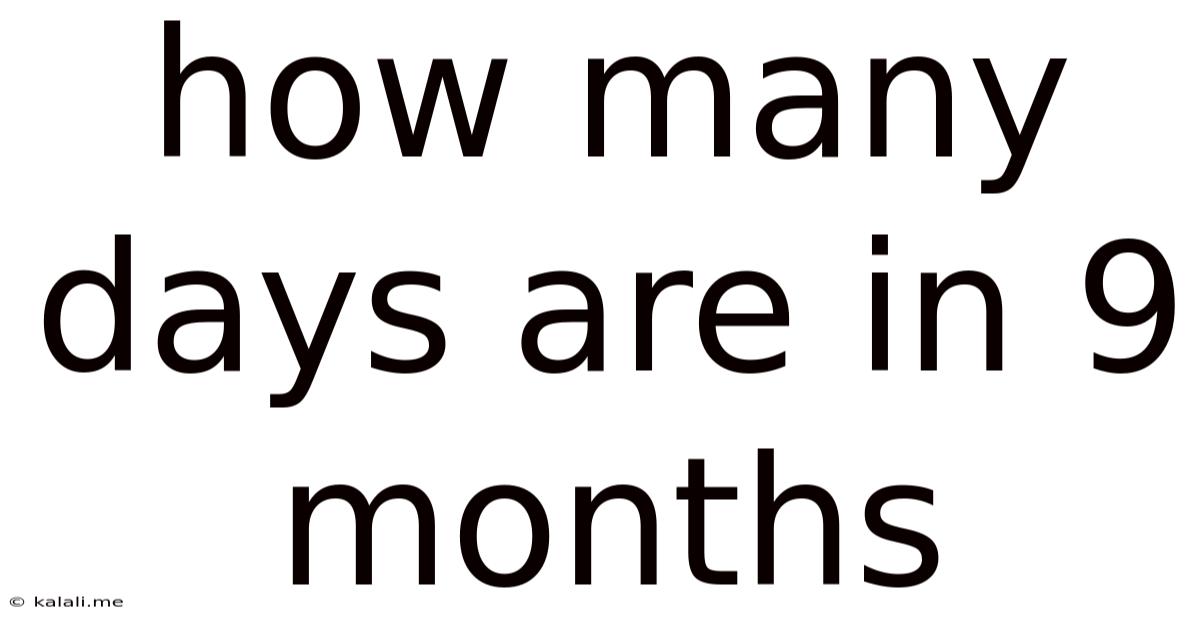How Many Days Are In 9 Months
Kalali
Jun 29, 2025 · 4 min read

Table of Contents
How Many Days Are in 9 Months? A Comprehensive Guide
Determining the exact number of days in nine months isn't as straightforward as it might seem. While a simple calculation might lead you to believe it's 270 days (9 months x 30 days/month), this ignores the varying lengths of months in a calendar year. This article will delve into the complexities of this seemingly simple question, exploring various calculations, common misconceptions, and real-world applications of this knowledge. Understanding the nuances of this calculation is crucial in various fields, from pregnancy calculations to financial planning involving monthly payments.
Understanding Calendar Months and Their Variability
The core problem lies in the inconsistent length of months. A year consists of 12 months with varying lengths:
- 30 days: April, June, September, November
- 31 days: January, March, May, July, August, October, December
- 28 days (or 29 in a leap year): February
This variability makes a simple multiplication inaccurate. The total number of days in nine months depends entirely on which nine months you're considering.
Calculating the Number of Days in Nine Months: Different Scenarios
Let's explore different scenarios and calculations to illustrate the variability:
Scenario 1: Nine Consecutive Months Starting from January
If we consider nine consecutive months starting from January, the calculation would be:
31 (January) + 28 (February) + 31 (March) + 30 (April) + 31 (May) + 30 (June) + 31 (July) + 31 (August) + 30 (September) = 273 days (assuming a non-leap year)
Scenario 2: Nine Consecutive Months Starting from February
Starting from February (in a non-leap year):
28 (February) + 31 (March) + 30 (April) + 31 (May) + 30 (June) + 31 (July) + 31 (August) + 30 (September) + 31 (October) = 273 days
Scenario 3: Nine Consecutive Months Starting from March
Starting from March:
31 (March) + 30 (April) + 31 (May) + 30 (June) + 31 (July) + 31 (August) + 30 (September) + 31 (October) + 30 (November) = 273 days
Scenario 4: Nine Months – Considering Leap Years
The presence of a leap year significantly impacts the calculation. If February falls within the nine-month period and it's a leap year, February will have 29 days, adding one day to the total. For instance, if the nine-month period includes a leap year, the total number of days could be 274 days, depending on the starting month.
The Importance of Specifying the Months
These examples demonstrate the crucial need to specify which nine months are being considered. A simple answer of "270 days" or even "273 days" is imprecise and potentially misleading without this crucial context. The variations are significant enough to matter in several real-world applications.
Real-World Applications: Why Precision Matters
The accurate calculation of the number of days in nine months is essential in various fields:
-
Pregnancy: While pregnancy is typically calculated as 40 weeks (approximately 280 days), doctors and midwives might use different gestational age calculations involving months. Understanding the variability in the number of days in nine months is crucial for accurate estimations and tracking of fetal development. This knowledge helps in setting due dates and monitoring pregnancy progress. Knowing the specific months is key in these calculations.
-
Financial Calculations: Calculating interest on loans, mortgages, or investments that are compounded monthly requires precise calculation of the number of days in each period. Using an average number of days per month can lead to significant inaccuracies, particularly over longer periods. The correct calculation depends on which nine months are relevant to the specific financial instrument.
-
Contractual Obligations: Contracts that involve monthly payments or deadlines might require precise calculation of the number of days within nine months. Miscalculating can lead to disputes and financial consequences. Again, specifying the months is paramount for accuracy.
-
Project Management: In project management, if a project spans nine months, accurate day calculation is necessary for scheduling tasks, allocating resources, and monitoring progress. Underestimating or overestimating the number of days can lead to delays and cost overruns. The actual number of days significantly influences project timelines.
Common Misconceptions and Errors to Avoid
-
Assuming all months have 30 days: This is the most common mistake, leading to significant inaccuracies in calculations.
-
Ignoring leap years: Failing to account for leap years can lead to off-by-one errors, particularly when dealing with February.
-
Not specifying the start and end months: Providing a precise answer without clarifying the starting and ending months makes the result ambiguous and potentially useless.
Conclusion: The Importance of Context and Precision
There's no single answer to "How many days are in nine months?" The number varies significantly depending on the specific nine months considered and whether a leap year is involved. The precise calculation requires careful consideration of the calendar and the specific months in question. Understanding this variability is essential for accurate calculations across numerous fields, highlighting the importance of context and precision in seemingly simple mathematical problems. Always specify the months involved to avoid ambiguity and ensure accuracy in your calculations.
Latest Posts
Latest Posts
-
How Many Yards In 1 8 Mile
Jun 29, 2025
-
How Many Centimeters Are In A Kilogram
Jun 29, 2025
-
Name Of The Boat In Step Brothers
Jun 29, 2025
-
What Did The Candle Say To The Match
Jun 29, 2025
-
What Is The Product Of 2 31 And 0 21
Jun 29, 2025
Related Post
Thank you for visiting our website which covers about How Many Days Are In 9 Months . We hope the information provided has been useful to you. Feel free to contact us if you have any questions or need further assistance. See you next time and don't miss to bookmark.